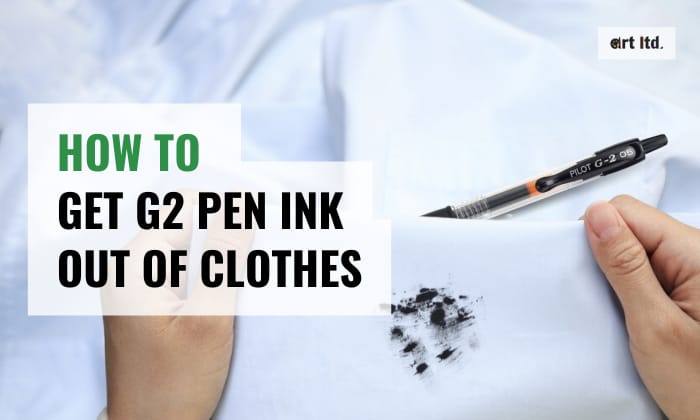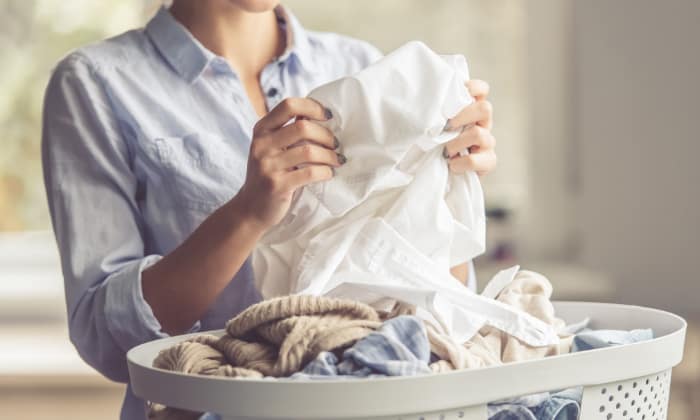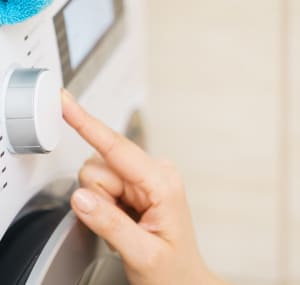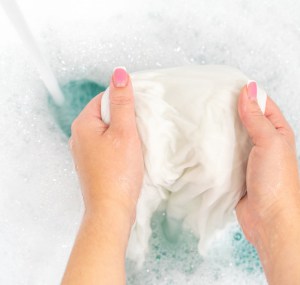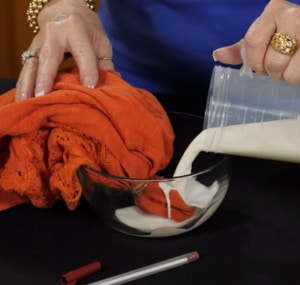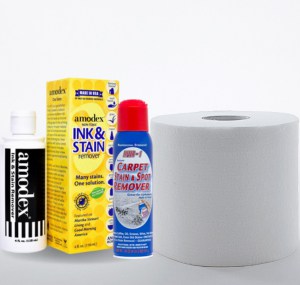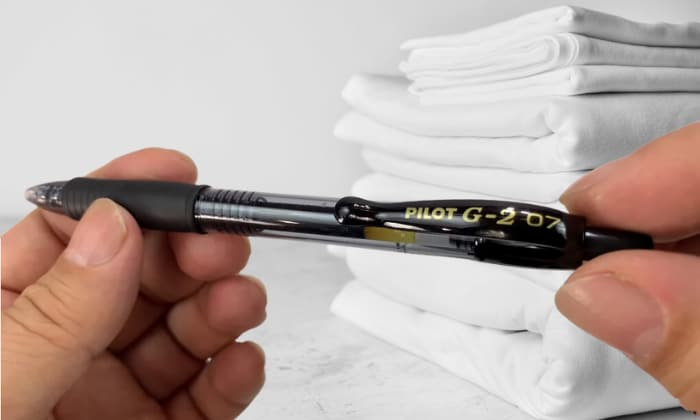There’s no denying G2 pens from Pilot are some of our favorite everyday pens. But what would you do if the pen stained your favorite clothing?
As Pilot G2 pens use water-based gel ink, which is inherently water-resistant, getting rid of their stains would require more than just water and soap.
In this article, we will learn how to get G2 pen ink out of clothes using different methods and get all your ink stain trouble away.
Table of Contents
Ways to Get G2 Pen Ink Out of Clothes
Pilot G2 pen stains need special treatment before washing in order to reactivate the ink for easier removal. As such, do not skip the pre-treatment step when you remove gel ink stains from your garment.
1. Washing machine method
This method is the best way to get rid of ink stains on colored clothes and for those that have been dried or have been in the clothes for some time.
If using this method to remove blemishes from white shirts and garments, you can replace the bleach-free stain remover with a solution of three parts water and one part bleach.
What To Prepare
- Alcohol-based sanitizer
- Bleach-free stain remover
- Mild detergent
- Water
Steps to follow
1. Pre-treatment
-
- Lay the inked cloth on a flat surface or in the sink.
- Saturate the ink satin with hand sanitizer and let it sit for a few minutes. This should initially solubilize the dried ink and activate it at a fiber level.
- Apply the stain remover on the ink stain and rub it gently. One cap of stain remover should be enough, though you can add more if needed.
- Let the solution soak for a maximum of 10 minutes—do not let the stain remover dry out during this time.
2. Set the washing water temperature to hot.
3. Load the pretreated clothes.
4. Add detergent and pour another cup of stain remover onto the load.
5. After the washing cycle is completed, check the stain. If ink stains persist, repeat the pre-treatment process and wash again.
2. Hand-washing method
This method is another good option if you are not comfortable using chemical-based cleaning products. The acidic nature of vinegar serves as your natural stain remover, while the alcohol will act as a solubilizer. Together they make a good tandem that can effectively remove gel ink from clothes.
What To Prepare
- 1 cup vinegar
- 1 cup 70% rubbing alcohol
- Salt
- Small bowl
- Cotton balls
- Hot water
- Small brush (such as a soft bristle toothbrush)
- Mild detergent
Steps to follow
1. Spot cleaning
-
- In a bowl, prepare the vinegar and rubbing alcohol mixture.
- Dip the cotton ball into the mixture.
- Dab it on the ink stain. This should lift the ink from the fabric. Continue dipping and dabbing until the ink starts to fade. Change the cotton ball if it gets stained as well.
- Sprinkle some salt and gently brush to completely remove the ink stain.
- Rinse off with hot water.
2. Hand wash with detergent.
3. Rinse with warm water.
4. Check for stains, and proceed to dry if you see no ink traces.
Other Effective Methods
1. Blotting with solvent method
This requires a good solvent such as alcohol, acetone base nail polish remover, or turpentine. Another alternative would be an alcohol-based hair spray.
Note: Gel ink stain removal with solvent is best done while the ink is still wet.
What To Prepare
- Choice of solvent
- White towel
- Paper towel
- Washing board
- Detergent
- Water
Steps To follow
1. Put a white towel on a washing board. Do not use a colored towel, as it might react with the solvent and make another stain.
2. Place the garment contaminated with gel ink on the towel.
3. Pour the solvent into the ink stain.
4. Use the paper towel to blot the ink and push it on the towel side.
5. Once the ink starts to transfer to the towel, be ready to transfer it into a clean area of the towel.
6. Keep blotting and use a fresh paper towel from time to time.
7. Once all ink is transferred, you can now wash the garment with the usual detergent and water.
2. Soaking with milk method
This method is another option for people who do not want to use harsh chemicals and strong odor solvents. You might wonder how milk removes ink stains from fabric.
A short explanation is that milk contains fatty lipids, while most ink contains organic pigments and solvents that are soluble in fats. This makes ink dissolve in milk in a similar way that it dissolves in common solvents like alcohol and acetone.
What To Prepare
- Milk
- Small basin or a big bowl
- Detergent
- Water
Steps to follow
1. Place the stained garment in a basin or bowl.
2. Pour enough milk to fully submerge the part with the ink stain.
3. Leave for at least 3 hours or overnight to let the reaction run its course.
4. Take the garment out and inspect if there’s no ink left.
5. Load it in the washing machine or hand wash as recommended.
3. Commercial ink remover method
This is the most straightforward method you can find. However, they are costly, and you rarely find them in single-use packaging.
Most commercial ink removers are not only designed to remove ink stains from shirts or clothing but for various surfaces such as carpet, upholstery, furniture, and ink stains that get into the skin.
What To Prepare
- Commercial ink stain remover, such as:
- Motsenbocker’s Lift Off #3
- Amodex Stain Remover
- Lifter-1
- Paper towel
- Detergent
- Water
Steps to follow
1. Saturate the ink spots with the stain remover.
2. Let the formula stay on for a few hours.
3. Occasionally dab the paper towel over it.
4. Reapply the ink stain remover and dab again with a paper towel.
5. Repeat the process until the stain is sufficiently removed.
6. Machine wash with detergent and water.
General Tips for Removing Ink Stains From Clothes
- Do not let the ink dry; treat them right away. This will prevent ink from permanently setting. After it is dry, you will have to use other options.
- Never put any harsh chemicals directly on the stain when treating colored clothes. Always test the cleaning agent or stain remover for colorfastness first.
- Make sure the ink is totally removed before loading it into the drier. The level of heat in the dryer may further set the ink on the fabric.
- Before treating the garment, check the tag for washing instructions.
- Some fabrics are too delicate for a DIY treatment. It is better to leave them to the expert.
Other tips & tricks to get ink out of clothes:
Tips for Preventing Ink Stains
- Avoid putting or leaving your pens in your pocket. The heat from the body temperature is enough to stimulate the ink and cause leaking.
- Keep your pen caps closed whenever it is not in use.
- If you have to carry a pen with you, place it in a pouch or pen protector before sliding it into your pocket.
Helpful Tips
How long does it take for G2 pen ink to set into clothes?
It will depend on some factors, like how much G2 pen ink is present, the surrounding temperature, and the type of fabric.
For most gel pen ink, it will only take 30 seconds to dry under normal conditions. That is why it is important to treat the ink stain as quickly as possible.
Can G2 pen ink stains be removed from dry-clean only clothes?
Yes. Spot cleaning and blotting using solvent, stain remover, or commercial ink remover is best for dry-clean only clothes. If ink stains are still visible after drying, it’s time to bring them to a professional dry cleaner.
In addition, any of these methods are not advisable for special fabrics like suede, leather, rayon, and cashmere. If this is your case, again, consider bringing them to a dry cleaning shop.
Conclusion
All sorts of ink stains, including stubborn gel pen stains, are equally challenging to remove. However, half of the battle is won if you’re able to work on them as soon as they land on your clothes.
At this stage, you can still blot the ink easily. However, gel ink can get dry too quickly. When that happens, you can pretreat it using stain remover and hand sanitizer or vinegar and alcohol.
Now that you know better how to get G2 pen ink out of clothes, saving your favorite clothes from ink stains will be a breeze.

Art has always been a part of my life; it influences my upbringing and later my career choice. For me, it is always a part of my parenting technique. So for whichever purpose that you come to art, you can start here with us.
